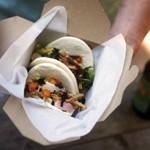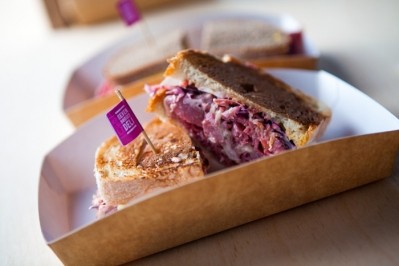Street food is big business opportunity

The street food phenomenon is a big trend in London and other cities, pulling together a range of cuisines from around the world into a movement built on cooking fresh food, often to order. And while the attraction of homemade packed lunches in the austere climate has left some conventional lunchtime and snack offerings struggling to compete for the out-of-home market, the lure of novel flavours and formats could be the key to persuading people to leave their cheese-and-pickle staples at home in search of lunchtime excitement.
“Street food is about portability and eating on the move. What makes it a bit ‘buzzier’ is the atmosphere around the stalls, and that's harder for mainstream retailers to reproduce,” says Tony Goodger, trade sector manager for BPEX, which is a division of the Agriculture and Horticulture Development Board focusing on pork. “Manufacturers and retailers are missing a trick by not getting involved in the street food trend.”
“Foodservice is getting a lot more inventive and street food is getting a lot of coverage,” says Helena Spicer, senior analyst with Mintel. “It’s about putting the excitement back on the menu. People need to be convinced to spend money, rather than bringing their own packed lunches.
“It’s easier for restaurants to pick up on these trends because they’re serving food fresh. It’s harder for retailers, but there are ways round it,” she says. So, while sandwich chains such as Eat serve up soup pots in bold flavours like Jerk Chicken, Tortilla Chicken, Malaysian Beef Rendang and Thai Green Chicken Curry, manufacturers and retailers are responding with meal pots aimed at chiller cabinets, ensuring that it’s about more than sandwiches. “We’re seeing more noodle pots and meal pots from firms like Innocent, for example,” says Spicer.
Goodger suggests that retailers and foodservice outlets that have historically catered mainly for the cold lunch or snack market are also starting to appreciate the potential of hot food. “Look at the more forward-thinking food retailers/foodservice outlets that specialise in food-to-go such as Pret a Manger and you'll see a fixture with hot wraps filled with street-food-inspired fillings such as meatballs.”
Retailers’ assets (Return to top)
But he also says many retailers are not yet making the most of their existing assets: “An increasing number of retailers and foodservice outlets have hot food-to-go fixtures adjacent to their cold sandwiches and snack areas and yet these fixtures tend to be the preserve of hot breakfast buns in the morning moving to pastry based lines from lunch to mid-afternoon, after which they often become empty.”
For Goodger, sweating these assets by introducing options with a street food feel is often a matter of adapting the foods that firms are already producing successfully: “Clearly any manufacturer who produces wraps at present can also make burritos and, rather than sell these neatly sliced into two for cold eating, sell them as whole wrapped Mexican burritos to be reheated in store and then presented on the hot food-to-go fixture.”
Similarly, the popularity of supermarket rotisserie counters can be exploited by expanding the offer from chickens to products such as meatballs or pulled pork that could be assembled into a hot sandwich to take away.
“Another characteristic of street food is that it often combines unusual flavours. Consumers are intrigued by this and open to trying new sensory experiences,” says Mirjam van Veldhuizen, marketing manager for savoury flavours at seasonings specialist Frutarom. However, she acknowledges that there’s a balance to be struck in terms of novelty in mainstream product development. “For firms exploiting the street food trend, it is a trade-off between standing out from the crowd and catering for the masses.”
Sources of inspiration (Return to top)
Frutarom has been helping manufacturers to tap into this trend towards street food flavours and formats for some time. “As a seasonings supplier, this is a vital source of inspiration. Last year, for example, we introduced a Levant marinade inspired by falafel: a very popular North African street food speciality,” says van Veldhuizen. “Another innovation launched this summer was our Masala variant, in which we have mixed and adjusted Indian spices to suit the European palate: tomato meets pepper, cardamom, ginger and coconut.”
The company's latest addition to the range seeks to exploit a unique window of opportunity to tap into a growing interest in all things Brazilian, which ties in with upcoming sporting events.
“We took our inspiration from the vibrant and diverse street food culture that exists in Brazil,” explains van Veldhuizen. “The country's cuisine is especially interesting as it really is a true melting pot of influences from indigenous Brazilian food, Europe, the Middle East, Asia and neighbouring South American countries. These influences can also be seen in Brazilian street food, which includes a variety of products, from fried shrimp balls, cheese bread to pasties and skewers.”
The range comprises marinades, seasonings and deco seasonings, so Brazilian flavour can be added to the protein component of sandwiches and wraps. For example, the Copacabana marinade gives plain chicken a fresh and fruity character with a subtle note of orange, while the Churrasco marinade provides beef with a smoky note, refined with pink pepper.
Cooking techniques also play a key role in the character of street foods, which is something Tulip Foods aims to reflect with its recently launched range of pulled meats. These are designed to help food-to-go operators deliver a slow-cooked experience in a few minutes. Tulip is best known for its pork products, but in addition to its Simply Best BBQ Pulled Pork Shoulder and Ham Hock, it has introduced Simply Best Pulled Chicken and Simply Best Shredded Beef Brisket. The products are sous vide cooked to produce a texture like that achieved by the American tradition of low, slow cooking on an open fire.
Pulled products (Return to top)
“Pulled products are really moist and can carry a flavour really well,” says Simon Shirley, director of Tulip’s Foodservice division, which was itself relaunched in recent weeks. “With street food, what makes it really interesting is how diverse it can be. We're not only talking about a lamb chop or a chicken wing. That diversity is something that everybody can play with.” He agrees that Brazil is set to be the big flavour trend over the next year and Mexican flavours are still growing.
While exotic cuisines and cooking techniques are undoubtedly a big part of street food, a lot of more familiar snack and lunchtime foods already derive from the street food scene. According to Goodger, all that's often lacking in these established products is the theatre that accompanies the street food experience. “Think falafel, burgers, hot dogs, ribs and jerked chicken,” he says. “All are staples in the manufacturers’ ranges and on the shelves of the multiples and yet none really tell a story of where the food originates from. We see foods carrying images of farmers and fields used to merchandise food to great effect in both the retail and foodservice channels, so why not images of streets and street chefs?” he says.
In the case of such long-standing favourites, the key to generating a renewed buzz might be to head up-market with products such as gourmet hot dogs, or ‘haute dogs’. Specialist bread manufacturer Butt Foods also says this illustrates that street food is about more than just the protein. It’s the carriers that often lend it the necessary portability and they also have a role to play in lending street food its personality.
“What are known as ‘haute dogs’ are very fashionable now, both on the street and inside establishments, like pubs and restaurants, which is why we’ve developed our new hot dog roll,” says Butt Foods md David Williams. Available in two flavours: classic and brioche, the new big softy toploader hot dog roll is egg-glazed and baked individually so there's no join mark.
“We also manufacture folded flatbreads, which again have increased in popularity via the street food trend. They are versatile and can be used as part of a range of meals with different fillings. Our customers tend to be food manufacturers, who are using different breads as part of meal packs, or foodservice operators, and I feel both of these sectors are influenced by street food trends."
“Manufacturers need to think about how and where the consumer is going to eat the food and then start with the ‘food carrier’," confirms Goodger. “While bread is still the most common ‘food carrier’, other world 'breads' are becoming increasingly popular."
In fact, one of the contenders for the ‘next big thing’ is the steamed bun, with several observers suggesting that 2014 could be the year this oriental-influenced street food finds mass-market appeal. “We’ve had wraps for years but could the steamed bun go mainstream, with its ability to absorb a sauce or flavour whilst supporting the other dish elements?” asks Goodger.















